About The Contaminated Sites Program
Contaminated Sites in Alaska
DEC’s Contaminated Sites (CS) Program protects human health and the environment by identifying, overseeing, and conducting timely, science-based, and defensible characterization, cleanup, redevelopment, and management of contaminated sites in Alaska, by ensuring information about illegal drug manufacturing properties are available to the public, and by preventing releases from underground storage tank systems.
A contaminated site is a location where hazardous substances, including petroleum products have been improperly disposed, spilled, or leaked from their containers. Contaminated sites often threaten public health or the environment and can cause economic hardship to people and communities.
Contaminated areas are often found where hazardous materials are used or released including:

Disrupted asphalt drums at the Riverbend Subdivision in Juneau.
- military bases,
- bulk fuel storage sites (including gas stations),
- airports,
- residential areas,
- old dump sites,
- abandoned mines, and
- oil extraction and transport sites.
The persistence of contaminated sites in Alaska is a threat to human health and the environment, often imposing economic burdens on surrounding communities.
DEC’s general authority is found in Alaska Statutes (AS 46.03). The statutes give DEC authority to develop and adopt regulations which typically provide more specific guidance to the regulated community on how to meet the statutory requirements.
The CS Program enforces these regulations within the Alaska Administrative Code (ACC):
- 18 AAC 75 Oil and Other Hazardous Substances Pollution Control,
- 18 AAC 78 Underground Storage Tanks, and
- 18 AAC 79 Illegal Drug Manufacturing Sites.
The CS Program maintains a regulatory cleanup process, sets cleanup levels, provides oversight for response actions, and develops guidance materials. The Program also:
- Reviews and approves analytical laboratories for conducting soil, water, and air analyses at contaminated sites/Leaking Underground Storage Tank (LUST) sites (18 AAC 78.800).
- Maintains a list of illegal drug manufacturing sites and provides guidance for remediation (18 AAC 79).
- Reviews and approves operation plans for offsite or portable soil treatment facilities. (18 AAC 75.365 and 18 AAC 78.273).
- Provides technical and regulatory assistance on regulated Underground Storage Tank (UST) systems in Alaska (18 AAC 78).
- Operates the DEC Brownfields Program to evaluate contaminated property for reuse.
The CS Program revises and develops regulations as new contaminants emerge or relevant studies alter the basis of current regulations. Research is always changing what we know, and the CSP Program is committed to progressing accordingly.
Learn more about the basics of regulatory authority and the CS Program from the Environmental Laws and Regulations fact sheet.
Becoming familiar with common contaminants in the environment is important to prevent further spread and exposure to contaminants in your area. The contaminants most commonly found in Alaska are among those commonly found elsewhere in the United States:
- Petroleum - the most common type of contaminant in Alaska
- Hazardous Substances
- Volatile Organic Compounds
- Solvents, dry cleaning fluids
- Benzene (a common component of petroleum)
- Toluene
- Volatile Organic Compounds
- Bioaccumulative compounds
- Per and polyfluoroalkyl substances (PFAS)
- Polychlorinated biphenyls (PCBs)
- Some pesticides and herbicides
- Some petroleum compounds, such as polycyclic aromatic hydrocarbons (PAHs)
- Metals, such as lead, zinc, various forms of mercury, chromium, arsenic and tin, etc
- Some solvents, such as trichlorobenzene
- Explosives
- Royal Demolition Explosive (RDX)
- High Melting Explosive (HMX)
- Nitroglycerin
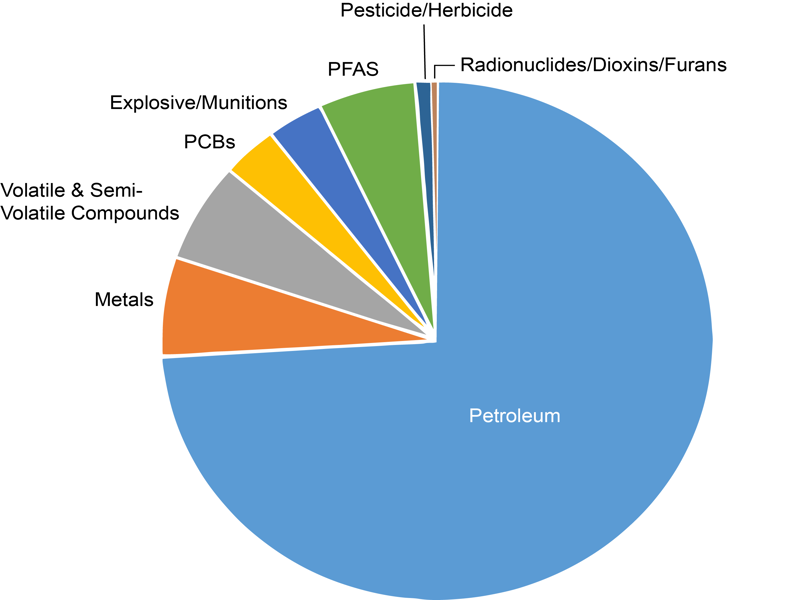
Visual representation of approximate percentages of contaminants of concern for contaminated sites in Alaska. Petroleum is by far the most common contaminant in Alaska.
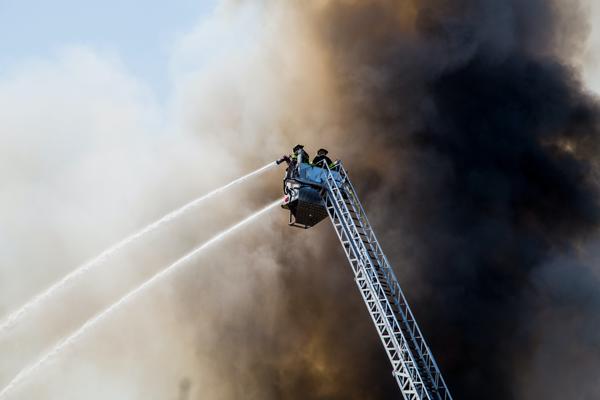
Contamination can also result from historical uses of products once considered safe, such as:
- leaded gasoline,
- arsenic-treated wood, and
- aqueous film-forming foams (AFFF) for firefighting or fire training activities
Find more detailed information about likely sources, environmental and health risks, and other types of contamination in the Contaminants in Alaska fact sheet.
State and federal environmental laws require those responsible for spills or releases of petroleum and hazardous substances to clean it up according to state standards and to bear the associated costs. Responsibility for contamination in Alaska is defined in Alaska Statute (AS) 46.03.822, which outlines those who are liable for the release of a hazardous substance. The general liability categories include:
- Those who owned or controlled the hazardous substance at the time of its release;
- Those who own(ed) or operate(d) the property or facility from which the release occurred;
- Those who own or operate the property at which the hazardous substance came to be located; or
- Those who arranged for transport, disposal or treatment of hazardous substances that were released.
Responsible persons can range from the government at large military installations to individual homeowners. Federal facilities make up a significant portion of Alaska’s contaminated sites and fall under federal government responsibility. Other responsible persons include local municipalities, business owners, large corporations, and other entities.
Identifying liability can be complicated. The CS Program works closely with the Alaska Department of Law to identify responsible persons. DEC incurs many costs while overseeing cleanup and is required by law to seek recovery of those expenses from liable persons.
Learn more about cost recovery for contaminated sites, the Defense-State Memorandum of Agreement, and how to get in touch with the Cost Recovery Section in the Cost Recovery fact sheet.
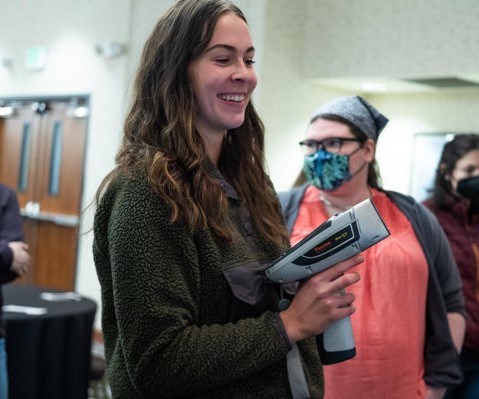
CS staff learning to use an XRF to quantify metal concentrations in soil, rock, or fluids.
The CS Program is continually working to educate the people of Alaska through a collection of publicly accessible resources, conversations with concerned members of the public, and direct outreach by project managers.
The CS Program manages a public database of identified contaminated sites in Alaska. The database provides information like contact information for the assigned project manager, historical action items taken by project managers for a particular site, relevant documents, and site status. In addition, the Alaska DEC Contaminated Sites web map provides an interactive map view of sites catalogued in the database. The CS Program also offers technical guidance and forms related to contaminated sites work.
Another CS public resource is the Site Summary page which highlights the more high-profile contaminated sites in Alaska. Each site summary page includes more engaging information than the database listing including historical background information, images, and fact sheets. The fact sheets are a part of a series of free publications prepared by DEC to help people understand contaminated site cleanup issues. The others can be found on the Contaminated Sites FAQ page.
The CS Program also offers a comprehensive guide on groundwater contamination in Alaska, including an interactive web map that features approximate locations of groundwater plumes in Alaska. Contaminants from sources such as releases from dry cleaners, industrial facilities, and Department of Defense activities can enter the environment and seep into the groundwater - and subsequently, local water supplies. Learn more about prevention, risks, types of contaminants, examples, and groundwater contamination near you on the Contaminated Groundwater page.
The DEC Brownfields Program provides community outreach and training around brownfields in Alaska. This program offers many public resources including Brownfield Basics, Benefits of Brownfield Reuse, FAQ, Publications and Resources, and Brownfield Project Summaries.
Preventing spills of oil and hazardous substances to the environment is essential to protect human health and the environment. Education and outreach are important ways to engage the public in best practices when handling oil or hazardous substances.
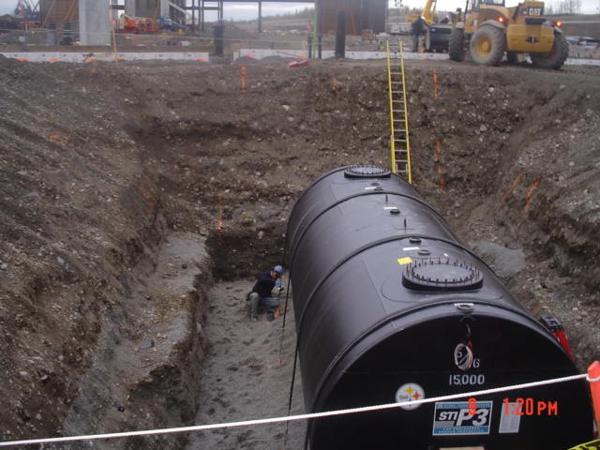
UST operator installing an underground storage tank.
Another way the CS Program works to prevent further contamination of Alaska's lands is through working to prevent future spills, like those from underground storage tanks. The Underground Storage Tank Section (UST) of the CS Program provides technical and regulatory assistance to owners of regulated underground storage tanks. In the event that an underground storage tank experiences a failure and releases contamination into the environment, it becomes classified as a leaking underground storage tank and is a contaminated site.
The primary focus of the CS Program is to protect human health and the environment from exposure to harmful pollutants released to soil or groundwater. Program staff work towards this effort using a number of tools and assurance practices during the cleanup process including regulating cleanup levels, utilizing the Exposure Tracking Model, and overseeing laboratory methods and handling procedures.
Cleaning up soil and groundwater after a leak or spill can be quite difficult, time-consuming, and expensive, but foremost in the process is protecting the health and safety of people and the environment. The cleanup process can range from a large, formal cleanup lasting several years with extensive public involvement to a simple one taking a few months. It all depends on the source, extent of contamination, and the threat to people and the environment.
The first step in the cleanup process is to prepare a Site Characterization Work Plan for DEC review and approval. This entails researching information about the site history and use, the types of petroleum or hazardous substances stored, used or disposed of on the property, and any information on known or suspected spills, releases or disposal of such materials.
Using the work plan as a guide, a qualified environmental professional or qualified sampler collects samples from the various environmental media and gathers more information at the site. After fieldwork is complete, the qualified environmental professional prepares a Site Characterization Report. The CSP Program oversees and reviews this fieldwork and reporting. The Contaminated Sites Laboratory Approval program ensures that laboratories use currently approved methods and handling procedures when analyzing samples of soil, air, or water for contaminants. The use of correct methods and procedures is critical to ensure that the results from the data accurately reflect the levels of contamination at the site.
An important part of the cleanup process is determining cleanup levels. Cleanup levels, set in State regulation, are the highest concentration of a hazardous substance that may be left in soil or water without posing a threat to human health or the environment. Different levels may apply depending on the contaminants present, the soil types, depth to groundwater, and the possible exposure routes (i.e., inhalation, ingestion, dermal exposure).
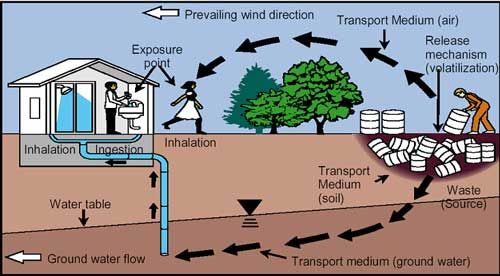
The Exposure Tracking Model (ETM) is a ranking system used to determine which sites present the greatest risk of exposure.
CS Program staff use this system to evaluate risk, track its reduction over time, and prioritize the Program’s efforts. Sites that present the greatest risk to human health are the highest priority for cleanup.
The responsible person will then submit a Site Cleanup Work Plan to DEC for approval. DEC provides oversight and potentially site inspections during the cleanup process. Interim cleanup reports may be necessary depending on the extent of fieldwork required, but a Final Cleanup Report is completed for DEC review and approval after all cleanup activities are complete.
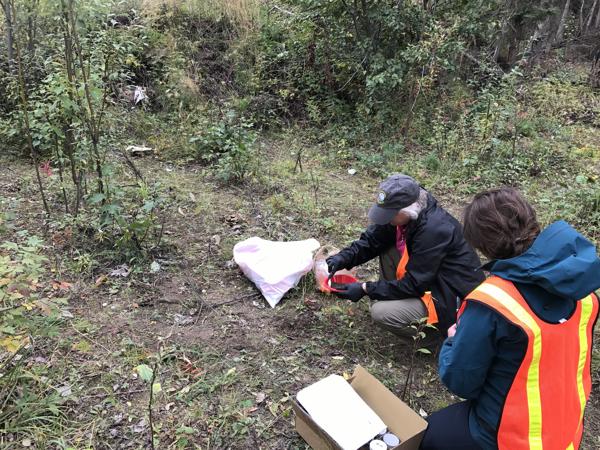
CS staff collecting samples at a shooting range in Delta Junction.
Historical contamination can be time-consuming and difficult to address. Little may be known about the source and volume of the contamination or how deep and far it may have spread. Many sites require long-term management to prevent exposure to humans and wildlife. The decision to end cleanup efforts at a contaminated site can occur in one of two ways:
Cleanup Complete: Sites where remediation efforts are complete and any remaining contamination is below the levels that would pose a threat to human health or the environment, the CS Program issues a “Cleanup Complete” determination. These levels are set through state regulation. A site may be reopened later, however, if more contamination is discovered or cleanup levels change.
Cleanup Complete with Institutional Controls: In some cases, complete cleanup of the soil and/or groundwater at a site is not technically or economically feasible - or perhaps even necessary. A common example is pollution which has spread underneath buildings or roads. In this scenario, the CS Program may issue a “Cleanup Complete with Institutional Controls” determination. This designation is typically granted for sites where active cleanup is complete and measures can be taken to protect people from exposure while allowing the property to be put back into reuse. These measures, which include conditions or restrictions to limit future land use activities and exposure, are called “institutional controls.”
The Cleanup Complete with Institutional Controls determination requires periodic reporting to the CS Program to ensure that the institutional controls are in place, and the cleanup is still protective. Learn more about environmental covenants, notices of activity and use limitations, and examples of institutional controls on the Institutional Controls fact sheet.
Real or perceived contamination can complicate the reuse of property and impact the economic well-being of many Alaskans. The CS Program uses a variety of tools to promote reuse of this land, facilitate redevelopment and protect future land users from exposure if some contamination remains.
A Prospective Purchaser Agreement is one of these tools. This is an agreement between the State of Alaska and a future landowner that clarifies liability for ongoing or future cleanup costs. The CS Program tracks these agreements and may require periodic reporting or conduct inspections to verify that conditions or terms of the agreement remain in effect.
If you are considering buying, selling, or developing potentially contaminated property, visit our Contaminated Real Estate page for more information.

Pelican Seafood Processing Plant, a DEC Brownfields Assessment and Cleanup project.
The CS Program’s Brownfields section works with local governments, tribes, and community stakeholders by providing information, funding, technical assistance, and other resources to facilitate the assessment and/or cleanup of property whose reuse is hampered by real or perceived contamination. The Brownfields section provides services and technical support on a project-specific level. Each year, the Brownfields section accepts applications each year to fund characterization and cleanup activities through the DEC Brownfields Assessment and Cleanup (DBAC) Program. Considered sites for the DBAC program must meet certain eligibility requirements. Learn more about eligibility, the selection process, and how to apply on the DBAC fact sheet.
Have questions? Visit our Contact page to get in touch with a Contaminated Sites staff member.


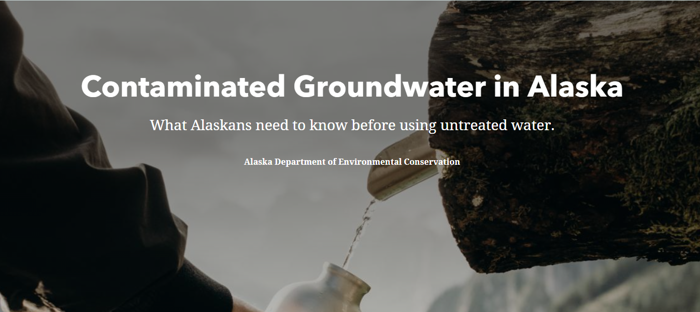
 Indicates an external site.
Indicates an external site.